In a significant move to rejuvenate its brand identity and financial performance, Burberry has unveiled its “Burberry Forward” strategic overhaul, aiming to re-establish its connection with customers by prioritizing core heritage designs and statement pieces. Announced on a recent Thursday, this initiative marks a pivotal moment for the luxury fashion house, as it looks to navigate through challenging market conditions and declining sales. The luxury sector has been experiencing a contraction, yet Burberry hopes that a robust focus on its fundamental product lines, such as its iconic coats and scarves, will reinvigorate consumer interest and drive profitability.
Market Response and Financial Implications
The announcement has been positively received in the financial markets, causing Burberry’s shares to soar by over 22% at one point—a historic intraday gain for the luxury brand. Although shares are still down approximately 39% year-to-date, this spike indicates a renewed investor confidence following the strategic announcement. Analysts view this initiative as a potential turning point for Burberry, acknowledging that under new CEO Joshua Schulman, who took the helm in July, there is a strong push towards realigning the brand with its original purpose. Schulman’s statement about the necessity for urgent corrective measures reflects a deep understanding of the challenges that have constrained Burberry’s growth over recent years.
Reconnecting with Core Products
In his address, Schulman emphasized that Burberry had drifted away from its revered core products, becoming overly influenced by niche market trends. This misalignment has strained the brand’s relationship with its traditional customer base. Moreover, the shift towards an “elevation strategy,” particularly in whimsical leather goods, became disjointed from its overarching market positioning. By returning to its roots, Burberry aims to enhance authenticity, a strategy experts consider essential for standing out in the increasingly competitive luxury market.
Financial analysts have weighed in on Burberry’s strategic pivot with cautiously optimistic sentiments. Piral Dadhania from RBC Capital Markets notes that the focus on heritage and outerwear represents a long-anticipated strategic alignment, providing Burberry with a unique selling proposition in a saturated marketplace. Mamta Valechha of Quilter Cheviot echoed these sentiments, heralding the shift as a turning point during a particularly challenging phase for the brand.
Thomas Chauvet, leading luxury goods equity research at Citi, projected that the brand would see substantial shifts in product design, pricing structure, distribution tactics, and communications—all while maintaining its status as a global luxury entity. These anticipated changes are crucial for revitalizing Burberry’s brand image and foot traffic, essential components for long-term sustainability.
Speculation had swirled around whether Schulman would embrace strategies akin to those of his previous employer, Michael Kors. The ‘British Coach’ approach could facilitate targeting a more aspirational demographic, perhaps through increased presence in outlet stores and a greater collaboration with off-price retailers. However, as Yanmei Tang from Third Bridge pointed out, the effectiveness of this strategic shift will hinge on Schulman’s ability to harmonize his business vision with that of Burberry’s creative team under Chief Creative Officer Daniel Lee.
The potential intersection of Schulman’s commerce-oriented mindset with Lee’s artistic vision represents both an opportunity and a challenge. Aligning these frameworks is crucial for developing a coherent product line that resonates with consumers without alienating the brand’s established identity. The emphasis on maintaining British heritage underscores a commitment to the values that initially defined Burberry as a hallmark of luxury.
As Burberry embarks on this ambitious journey of rebranding and revitalization, it will be imperative for the company to strike a balance between embracing its storied past and adapting to present consumer demands. If successful, the “Burberry Forward” initiative could not only stabilize the company’s finances but also solidify its status as a leading luxury brand. With a decidedly deliberate approach towards product selection and a renewed focus on authenticity, Burberry’s best days may indeed lie ahead. As the luxury market continues to evolve, how Burberry navigates this transformative process will serve as an instructive case study for other brands in the sector.


Leave a Reply